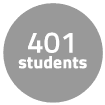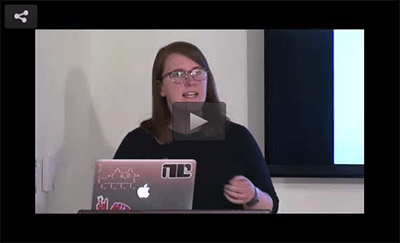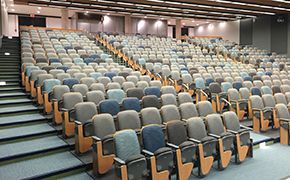Instructor Insights pages are part of the OCW Educator initiative, which seeks to enhance the value of OCW for educators.
In the following TLL Speaker Series lecture video, Dr. Katrina LaCurts describes various aspects of how she and her teaching team infused active learning into the recitation sections of 6.033 Computer System Engineering.
Infusing Active Learning into 6.033 Recitations
View by chapter
- What is Active Learning?
- Unique Aspects of the Course
- Why Infuse Active Learning into 6.033 Recitations?
- Getting Everyone on Board
- The Importance of Extensive Planning
- Supporting Staff as Individuals
- Supporting Staff as a Group
- Active Learning Activity: Group Work to Class-wide Discussion
- Active Learning Activity: Debates
- Active Learning Activity: Drawing Pictures
- Active Learning Activity: Acting Things Out
- Did Active Learning Work?
Curriculum Information
Prerequisites
6.004 Computation Structures
and 6.005 Software Construction or 6.009 Fundamentals of Programming
Requirements Satisfied
CI-M ![]()
Offered
Every spring semester
Assessment
Grade Breakdown
The students' grades were based on the following activities:
 35% Technical materials 35% Technical materials 40% Communication + System Design and Analysis 40% Communication + System Design and Analysis 25% Participation 25% Participation |
Rubrics
A rubric (PDF) was used to grade students’ design project final reports.
Student Information

Breakdown by Year
Mostly juniors and seniors
Breakdown by Major
Mostly EECS
Typical Student Background
Students tend to have knowledge of basic programming and computer architecture (how memory works, what a cache does, etc.). Often, since the class is targeted toward juniors and seniors, students have had at least one outside-of-class experience in computer science, such as an undergraduate research experience or an internship. Those experiences are helpful in that they give students a better sense of how large computer systems are in the real world.
During an average week, students were expected to spend 11 hours on the course, roughly divided as follows:
Lecture
- Met 2 times per week for 1 hour per session; 25 sessions total.
- The lectures were designed to teach students the technical details necessary to design their own systems and to put those details in larger contexts: both the contexts of a specific area of systems as well as systems in general.
Recitation
- Met 2 times per week for 1 hour per session; 27 sessions total.
- Recitations were designed to give students a chance to practice their system analysis and oral communication skills. Each recitation revolved around a particular paper in systems. Through reading these papers, students got a better sense of how communication in the field is done. Recitations were discussion-based and incorporated active learning; students got practice analyzing, critiquing, and communicating about systems.
Writing Tutorial
- Met 1 time per week for 1 hour per session; 10 sessions total.
- Most of the writing tutorials taught the communication theory and practices of this course, and assisted students in preparing for the assignments. Students became fluent in a variety of communication genres, developed strategies and skills needed to present technical concepts to different audiences, learned how to use writing to develop and deepen their technical understanding, and got specific, directed instruction on writing and presenting their 6.033 assignments. A handful of the tutorials were dedicated to discussing the design project.
Out of Class
- Out of class, students prepared for quizzes, completed readings and hands-on assignments, and worked on their design projects and system critiques.
Semester Breakdown
| WEEK | M | T | W | Th | F |
|---|---|---|---|---|---|
| 1 |  |  |  |  |  |
| 2 |  |  |  |  |  |
| 3 |  |  |  |  |  |
| 4 |  |  |  |  |  |
| 5 |  |  |  |  |  |
| 6 |  |  |  |  |  |
| 7 |  |  |  |  |  |
| 8 |  |  |  |  |  |
| 9 |  |  |  |  |  |
| 10 |  |  |  |  |  |
| 11 |  |  |  |  |  |
| 12 |  |  |  |  |  |
| 13 |  |  |  |  |  |
| 14 |  |  |  |  |  |
| 15 |  |  |  |  |  |
| 16 |  |  |  |  |  |
 No classes throughout MIT
No classes throughout MIT Lecture session
Lecture session Tutorial
Tutorial Quiz
Quiz No class session scheduled
No class session scheduled Recitation
Recitation Assignment due
Assignment dueCourse Team Roles
Lecturer (Dr. Katrina LaCurts)
The lecturer was in charge of the course. She planned and delivered lectures, planned recitations and writing assignments, managed course staff, handled a variety of student issues, and completed long-term planning for the course.
Recitation Instructors
Nine recitation instructors prepared for and led recitations (which included planning beyond that completed by the lecturer). They also gave feedback on assignments as they were being developed and graded and gave feedback on various design project deliverables.
Communications Instructors
Thirteen communication instructors led tutorial sections, which taught students communication concepts. They also graded a variety of written assignments.
Communication Coordinators
Two of the communication instructors also served as communication coordinators. In addition to the communication instructor duties, they managed the communications staff directly, and planned the communications curriculum. They interfaced directly with the lecturer.
Teaching Assistants
Nine teaching assistants held office hours, attended and observed recitations, occasionally led tutorials and recitations, helped recitation instructors assign participation grades, and graded some written assignments.
Administrative Teaching Assistant
The administrative teaching assistant helped coordinate the teaching assistants and graders, uploaded grades, and managed the course website.
Graders
Eight graders assessed the hands-on assignments. They worked remotely and had minimal interaction with most of the course staff (except for the lecturer and administrative teaching assistant).



 Room 1 of 2
Room 1 of 2 
